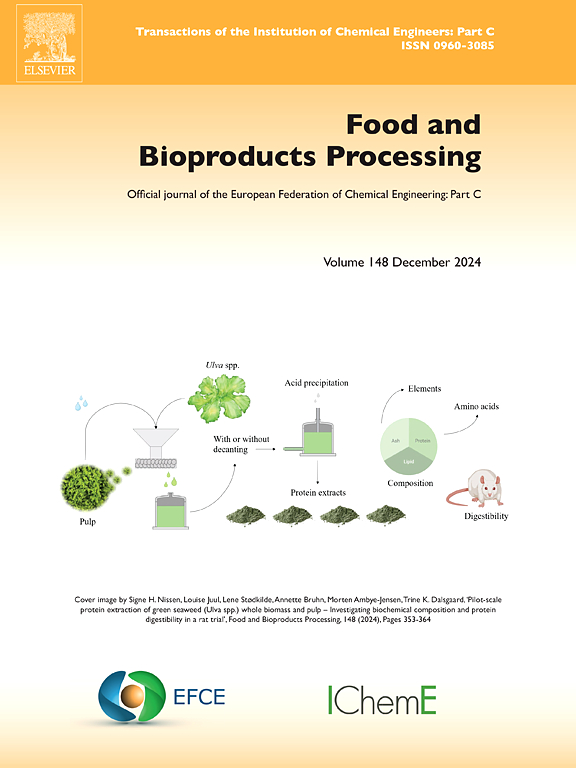Biocompatibility and mechanical properties of Curdlan-based hydrogels for cultivated fat production
IF 3.4
2区 农林科学
Q2 BIOTECHNOLOGY & APPLIED MICROBIOLOGY
引用次数: 0
Abstract
Scaffolding is one of the fundamental steps in cultured meat production, serving as a structure that supports cell attachment and imitates the conventional meat texture. Currently, there is limited information on the suitability of edible scaffolds suitable for cultivated fat applications. This study explores the potential of curdlan-based hydrogels combined with plant and insect proteins as scaffolds for cultivated lamb fat production as well as the effect of plasma treatment on cell adhesion of lamb fat cells. The hydrogels were evaluated for their morphology, mechanical, thermal, and surface properties to determine their suitability for supporting cell growth. Mechanical testing showed that the addition of proteins significantly improved the elasticity of the hydrogels, with black soldier fly protein showing the most notable enhancement. Thermal analysis revealed that protein incorporation into curdlan scaffolds shifts the melting temperature to lower temperatures. Complex proteins-polysaccharide changed the thermostability of the gel slightly, with the sharp peak temperature reduced compared to curdlan alone. Swelling tests demonstrated higher water uptake in protein-enriched scaffolds, indicating increased porosity and potential for enhanced nutrient transport. Biocompatibility assessments through cell viability assays showed that curdlan and hemp protein-enriched scaffolds supported lamb fat cell attachment better compared to other scaffolds. The effect of plasma treatment on surface activation of scaffolds, although increased surface hydrophilicity, negatively affected cell adhesion. These findings suggest that curdlan and protein-enriched curdlan hydrogels, specifically with hemp, have a potential for developing scaffolds in cultured meat applications.
用于培养脂肪生产的凝乳素基水凝胶的生物相容性和力学性能
脚手架是培养肉生产的基本步骤之一,作为支持细胞附着和模仿传统肉质地的结构。目前,关于适用于培养脂肪应用的可食用支架的适用性的信息有限。本研究探讨了以凝乳素为基础的水凝胶结合植物和昆虫蛋白作为养殖羊脂肪生产支架的潜力,以及血浆处理对羊脂肪细胞粘附的影响。对水凝胶的形态、力学、热学和表面性能进行了评估,以确定它们是否适合支持细胞生长。力学测试结果表明,蛋白质的加入显著提高了水凝胶的弹性,其中黑兵蝇蛋白的增强效果最为显著。热分析表明,蛋白质掺入凝乳支架使熔化温度降低。复合蛋白-多糖对凝胶的热稳定性有轻微的改变,与单独的凝乳蛋白相比,其尖峰温度降低。膨胀试验表明,富含蛋白质的支架吸水率更高,表明孔隙度增加,营养物质运输可能增强。通过细胞活力测定进行的生物相容性评估表明,与其他支架相比,富含凝乳蛋白和大麻蛋白的支架更能支持羊脂肪细胞的附着。血浆处理对支架表面活化的影响,虽然增加了表面亲水性,但对细胞粘附产生负面影响。这些发现表明,凝乳蛋白和富含蛋白质的凝乳蛋白水凝胶,特别是与大麻,有潜力开发支架在培养肉的应用。
本文章由计算机程序翻译,如有差异,请以英文原文为准。
求助全文
约1分钟内获得全文
求助全文
来源期刊

Food and Bioproducts Processing
工程技术-工程:化工
CiteScore
9.70
自引率
4.30%
发文量
115
审稿时长
24 days
期刊介绍:
Official Journal of the European Federation of Chemical Engineering:
Part C
FBP aims to be the principal international journal for publication of high quality, original papers in the branches of engineering and science dedicated to the safe processing of biological products. It is the only journal to exploit the synergy between biotechnology, bioprocessing and food engineering.
Papers showing how research results can be used in engineering design, and accounts of experimental or theoretical research work bringing new perspectives to established principles, highlighting unsolved problems or indicating directions for future research, are particularly welcome. Contributions that deal with new developments in equipment or processes and that can be given quantitative expression are encouraged. The journal is especially interested in papers that extend the boundaries of food and bioproducts processing.
The journal has a strong emphasis on the interface between engineering and food or bioproducts. Papers that are not likely to be published are those:
• Primarily concerned with food formulation
• That use experimental design techniques to obtain response surfaces but gain little insight from them
• That are empirical and ignore established mechanistic models, e.g., empirical drying curves
• That are primarily concerned about sensory evaluation and colour
• Concern the extraction, encapsulation and/or antioxidant activity of a specific biological material without providing insight that could be applied to a similar but different material,
• Containing only chemical analyses of biological materials.
 求助内容:
求助内容: 应助结果提醒方式:
应助结果提醒方式:


